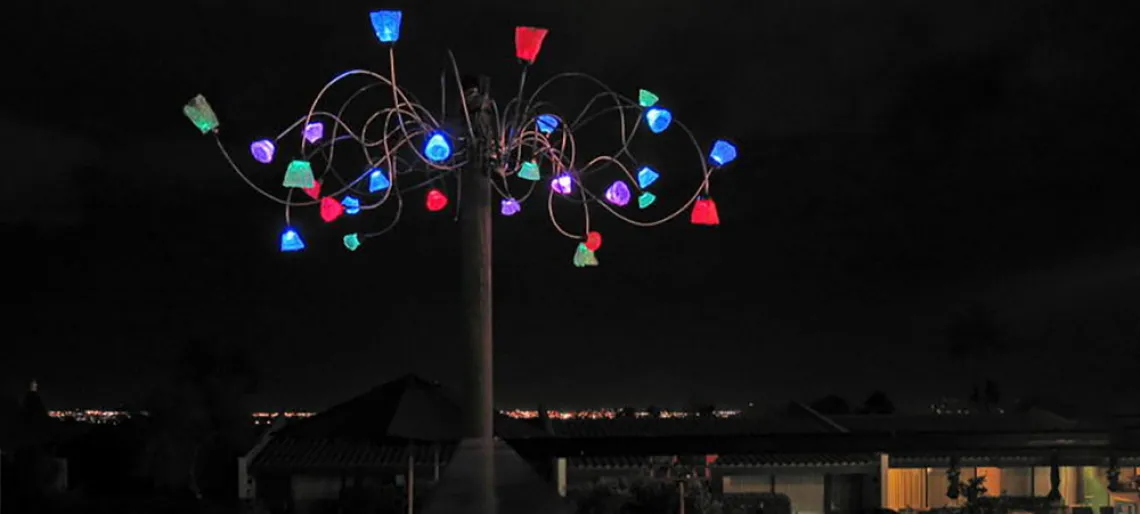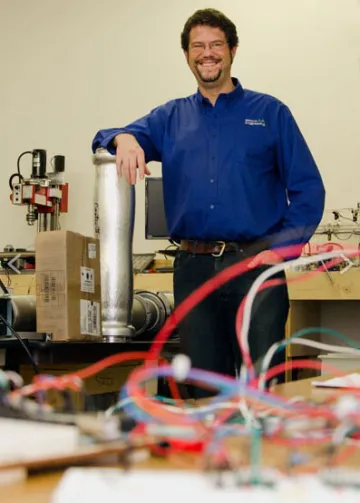Building New Technologies: Patrick Marcus '11 McGuire Entrepreneurship Program

Growing up, Patrick Marcus wanted to follow in the footsteps of his family members and become a doctor-lawyer-engineer. Though he ultimately decided law and medicine weren’t for him, he has found himself on a different hyphenated career path: engineer-entrepreneur.
As he finished his electrical engineering degree at the University of Arizona in 1999, Marcus realized his true passion lay in biomedical engineering. He stayed at the UA to pursue a graduate degree focused on neuroprosthetics and medical instruments. While he excelled in his undergrad studies, graduating with Honors, Cum Laude, he found his doctoral studies less engrossing.

“Graduate school wasn’t a good fit for my personality,” he said. “I wanted to build new technologies rather than study and research at a university pace, so I looked for other ways to engage myself.”
He got involved with local artist Stephen Fairfield who needed engineering help on a piece called Skyburst for Luminarias del Pueblo, a public art project that placed illuminated sculptures throughout Tucson in the winter of 2004. He also began doing part-time consulting for a small solar startup. That company needed a circuit board redesigned, and then some IT help, and then a bit of marketing assistance, and each time Marcus stepped up to fill the need. He found it exciting to be part of a company that was growing and adapting to be at the forefront of a changing industry so when he heard about the McGuire Entrepreneurship Program at the UA’s Eller College of Management, he realized it would be an excellent fit for his new interest in startups and innovation.
“I thought, ‘This is so cool. I can learn about how to build a business from a business perspective instead of an engineering perspective,’” he said. “The McGuire Program was one of the best experiences of my life. It opened up a whole new world and way of looking at things, specifically how business people think, which, is quite different from engineers.”
For his McGuire Program project, he developed a business plan for a company that produced very thin scratch-resistant glass coatings for plastic screens, such as ipods, ski goggles and motorcycle helmet visors. The concept won the 2006 year-end competition and Marcus was hooked on the idea of combining his engineering background with his new knowledge of how to launch and grow a business.
“It left me feeling confident that I could build something great, that if I wanted to raise money for any ideas I had, I could do it,” he said. “That is very empowering.”
It also left him eager to build a business based on the entrepreneurial principles he learned in the McGuire Program. In 2011, he left the solar startup where he had taken a director position after graduation and struck out on his own, founding Marcus Engineering, LLC, an electronics engineering firm.
Today, the startup he launched in his garage has two full-time engineers, three interns, three subcontractors and a part-time bookkeeper. While he acknowledges he can’t compete with large employers like Raytheon for salaries, he is dedicated to creating a positive and energized work environment. Marcus encourages innovation, collaboration and initiative in all of his employees, and, in addition to keeping a fully stocked fridge in the office for everyone to enjoy, he is a big fan of delivering unexpected rewards and tokens of appreciation.
“It’s the little things that have a big emotional impact,” he said.
Marcus Engineering primarily focuses on electronics, product development, systems integration and medical instrumentation. The company has produced a piece of fully automated test equipment for the laser systems used in military helicopters, a medical laser systems that send 3,000 watts of infrared light into the skull to measure oxygen concentration in the brain of surgery or trauma patients, and a sensory feedback system for diabetic patients who lack tactile senses in their extremities. The design and development lab is currently working on a system to control the distribution of thin film coatings used on solar panels, LCD displays and touch screens.
Marcus has also launched Apparently Connected with partner Nathan Crum, a startup that aims to create innovative ways to connect users and their devices. The newest offering from Apparently Connected is the Exigo USB Charger, a four-port USB charger designed from the ground up to be the fastest, most powerful and intelligent charger on the planet, Marcus said. A kickstarter campaign running through Oct. 3 aims to fund the production of the Exigo USB Charger.
Hooked by that first solar sculpture project he did in grad school, Marcus also founded Solar Sculptures and continues to enjoy creating public sculptures that integrate solar powered displays of light. He and partner Stephen Fairfield now have a half-dozen works located around the country, including sculptures in front of the Tucson International Airport and in front of Plaza Colonial.
“It’s an investment in outreach and marketing—and it’s fun,” he said.
His outreach efforts don’t end there. Marcus teaches, mentors and serves on advisory boards for several UA departments and centers and has worked with many entrepreneurship students.
“I’ve supported and helped a lot of McGuire Program student projects,” he said. “I want to see them get on the right path.”
Marcus, a fourth generation Tucsonan, is also very engaged with the Tucson innovation community. He is actively involved in Startup Tucson, the Arizona Technology Council and several statewide bioindustry associations. He believes that community-building efforts are essential and have a direct impact on keeping local talent here and building businesses in Tucson. He wants to see Tucson’s growing innovation corridor continue to expand and develop.
“I want to help grow the tech sector,” he said. “I want to help get this community going.”
Top photo of "Skyburst" courtesy Patrick Marcus

